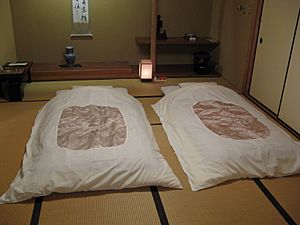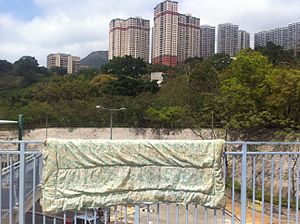Futon facts for kids
Futons are a special kind of bedding from Japan. A traditional futon has three main parts: a soft mattress called a shikifuton, a warm blanket called a kakefuton, and a pillow often filled with beans, known as a makura.
People used to place futons directly on the floor for sleeping. When morning came, they could easily roll them up and store them away. This made rooms useful for other things during the day.
Today, the word futon can mean more than just this traditional bedding. Even if Japanese people sleep in a regular bed, they might still say "I sleep on futon." It simply means they are going to bed. So, "futon" now refers to many things Japanese people sleep on, including modern beds.
Different Kinds of Futons
Many companies make futons, and there are lots of different types. Futons can be made from various materials. These include man-made fibers like polyester, or natural materials like cotton, feathers, down, and wool. Japanese blankets often have feathers inside, while Japanese mattresses usually contain wool.
The materials used in a Japanese blanket affect how well it keeps you warm and dry. For example, a futon with more than 50% hemp or cotton is called a Menfuton. These are popular all over the world.
Futons made from down are called quilt down. They are very good at keeping heat in, so they are considered high-quality futons. Futons made from feathers are called comforters. These are often cheaper and are common worldwide. Futons made from man-made fibers are also inexpensive and widely used. Futons made from wool are called Yomo futon, and they are very warm.
In winter, people often use a Hadafuton like a thin blanket to stay extra warm. In summer, people might use a Towelket, which is like a big towel, or a Seer quilt, which helps keep them cool.
Futons are usually used with a special cover. This makes it easy to keep the futon clean. People use futons to sleep comfortably, stay warm, and support their bodies. When you sleep, your body sweats, and futons can absorb this sweat and moisture. Because of this, futons need to be hung out in the sunlight to dry. This is called futon-hoshi. If they are not dried properly, tiny creatures like ticks and mold can grow, making the futon dirty. So, it's important to take good care of futons.
History of Futons
In the 13th century, most people in Japan slept on straw mats. However, important people, called nobles, slept on tatami mats. These early sleeping mats were not as soft as today's futons. They were often hard and not very comfortable. For a long time, people would use their own clothes as blankets to stay warm.
In the 17th century, the first real bedclothes were made. People created them by stuffing cloth with cotton and wool. These early bedclothes were the original form of the futon we know today.
By the 18th century, more cotton became available in Japan. This led to the start of futon production. Back then, the word "futon" usually meant the mattress part, not the blanket.
In the 19th century, futons became much more common. Raw cotton started to be imported, and many factories were built. Thanks to new industrial methods, making futons became easier and faster. This made futons cheaper, so more people could afford to buy them.
Modern Futons
One of the most famous futon makers in Japan is a company called "Nishikawa." This company has a history of 440 years and is located in Kyoto and Tokyo. They make everything for sleeping, including pillows, sheets, and blankets.
In the past, people just wanted a futon that was good enough to sleep on. But today, people want better futons that help them relax and recover from being tired. Futon makers have created new futons that can adjust to a person's body. These are called Seiatsu Futon in Japan.
These new futons have several benefits. They have good air flow, which means they stay cool in summer and warm in winter. They also help you sleep in a good position, which can improve blood flow while you rest. Plus, they are easy to care for. Another popular type of futon in Japan is the "low repulsion" futon. This kind is designed to fit the shape of the person using it. Some futons even have "tick guard" features to help people who are worried about ticks.
Images for kids
-
Cross-section of a tatami mat.
-
Museum samples demonstrating a 1590s bed.
-
The fairytale The Princess and the Pea exaggerates the traditional European layering of thin mattresses.
-
"Beds airing, Camp Funston, Kansas", in 1917 or 1918.
See also
 In Spanish: Futón para niños
In Spanish: Futón para niños



















